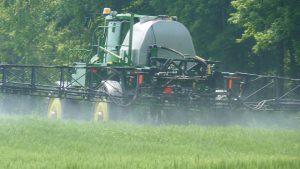Field observations
SPRING 2019 PLANTING ISSUES
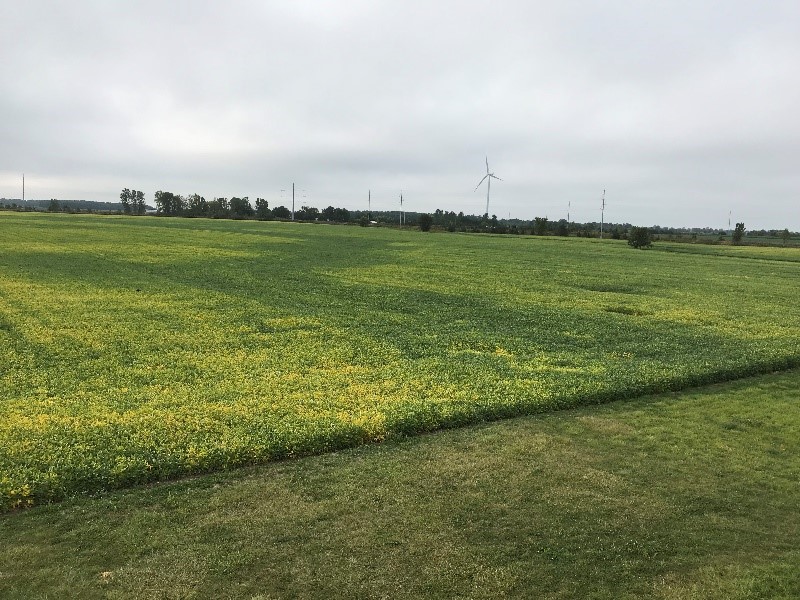
Update for September 13, 2019
It was a busy week in Ontario for farmers as Canada’s Outdoor Farm Show was held in Woodstock. Soybeans have begun to turn while the corn crop needs some more heat for the next three to four weeks.
CORN
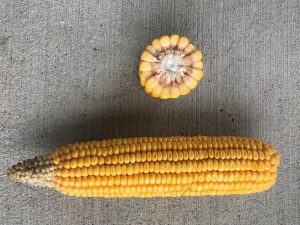
Corn across the province is in the dent stage (R5) this week. Once grain corn has hit the R5 stage, hard starch begins to be laid down on the cap of the kernel which in turn starts to firm up the kernel. As this hard starch layer is formed over the next three weeks, you will notice the difference of this progression as the tip of the kernel will be soft and milky while the cap is hard and starchy. The line between this is called the milk line. The colour difference will be evident as the cap will be yellow and the tip will be white. As the milk line progresses, the kernel becomes drier, the husks brown up, and the whole plant begins to dry down. This is the time silage producers start to evaluate crops for maturity and moisture and begin to prepare for silage harvest. Full grain maturity is still a good three to four weeks away for most corn. Once the milk line has disappeared, a black layer (abscission layer) will form; this will indicate the corn is mature and will be in the 32% moisture range.
SOYBEANS
Maturity is starting to set in on the soybean crop this week. Green fields last week have started to turn yellow this week. Some of the maturity has been hastened by the drier weather and lack of adequate rain near the end of the growing season, as is evident with the uneven ripening in fields with lower areas of the field remaining green. Maturity differences in varieties and planting date are also showing up as the crop is reaching maturity.
Pre-mature die down in the soybean crop will lead to smaller seed size and result in a loss in the top end yield of the crop. While rainfall this week will keep the green areas green and continue to size up the soybeans.
Lower lying areas of fields will remain greener as higher areas ripen earlier due to drought stress over the past few weeks.
CEREALS
Spring cereals in northern Ontario and slowly coming off in-between the rains. Harvest delays have occurred due to late spring planting and a wetter harvest period.
Winter wheat planting will begin shortly on unseeded acres. If growers are looking to plant winter wheat on cover crop acres, remember to control the cover crop with a herbicide application at least two weeks before planting the winter wheat to allow for enough time for the cover crop to die down.
CANADA’S OUTDOOR FARM SHOW
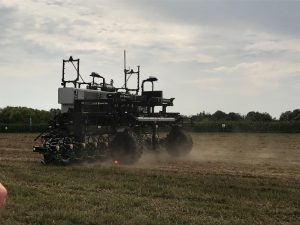

There was a lot to see and learn this week in Woodstock. New equipment and new technology were showcased at the show as farmers were able to also see live demonstrations on the Tuesday of strip tillage, cover crop tillage, and we got to see DOT run. Fully autonomist farm equipment for planting, spraying, and fertilizing was in full operation.
Update for June 28, 2019
Summer has arrived, temperatures have increased, and daily rains have subsided in Ontario. This week growers have been attempting to plant some of the untouched acres
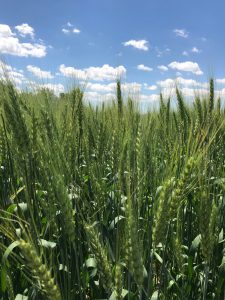
from the spring deluge of rain and progress is being made. Some areas have wrapped up seeding for the season while other areas have just started planting soybeans.
CORN
Corn fields are anywhere from just emerged to 8-leaf. A few fields are at either end of that range and a lot of fields are at the 3- to 5-leaf stage. Heat this week has advanced the crop, but it’s nowhere near where we have been in past years. In previous years, July 4 meant shoulder high corn to many farmers, this year knee high may be the best we can do. Side dressing is occurring, and farmers are working at keeping fields clean during the weed free period. Leaf emergence will occur at the average rate of 75 – 80 chu per leaf. With 28 C days and 18 C nights we will be accumulating 28 chu per day and will see a new leaf every three days. So growth progress will occur more rapidly with warmer summer weather, than compared to the cooler spring. With average summer temperatures it will still take all of July before we see the majority of the corn crop pollinate in August.
SOYBEANS
Lots of soybeans were emerging last week, with ample moisture to keep the crust soft to allow for unencumbered emergence. This week’s plantings may not fair as well, as the dry weather that allows planting, can also reduce emergence if planting was in less than appropriate conditions. Hot dry weather can dry the soil out quickly, and shallow and wet planting will suffer with open slot syndrome. Many areas on clay soils have now had a dry stretch in order to begin planting, lots of land is getting covered quickly.
WINTER WHEAT
Kernels are filling in the early planted crop in the south, while fields east and north are just heading out and will be pollinating in the upcoming week. Field variability is showing up with the delayed heading and pollination in most stressed fields. Variable maturity is inevitable with this crop and farmers will need to manage crop variability all the way to storage. Ontario Cereals Crop Committee (OCCC) wheat tours started in Woodslee this week and showed promise that some poor spring stands have filled out better than expected. Fusarium has slightly started to appear, but at lower levels than expected. This is just the start and conditions are variable across the province, the next few weeks will show more localized concerns.
Update for June 21, 2019
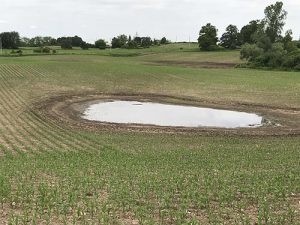
Spring 2019 has officially come to an end, and many farmers have all but given up corn planting. Soybean planting still has a ways to go, but we have seen some progress where rains have been light or a lucky miss. Insect populations are on the increase with warm temperatures and moist conditions allowing for abundant reproduction. The good news is that beneficial insects are also on the rise as the feed source is large. Wet soils are also creating great opportunities for seedling diseases.
CORN
Early planted corn has progressed to the 6th leaf, while June 8/9 planted corn is just emerging after eight days in the ground. Farmers that still have to apply nitrogen as side dress will be
attempting to apply as ground conditions allow, it is best to start early before the crop advances too rapidly.
Peter Sikkema, professor of field crop weed management at the University of Guelph, had a good reminder this week. From previous years’ data, we can expect corn yield losses of four bushel per acre for every one inch in weed height. Weed control from emergence to V6 is extremely critical and has more financial benefit than early soybean weed control. If you had to choose between which crop to spray, your best return will be in preventing yield loss in corn with early weed control.
SOYBEANS
Early planted soybeans have emerged and are getting well established. June 8/9 plantings are just emerging later this week. Showers have kept a crust from forming on fields, but they have also restricted the continuation of planting. A few pockets have dried up enough for planting to continue again in a few areas; still, some areas on the finer textured soils require more drying days. Essex, Lambton, and Niagara areas are affected the greatest.
If you are looking for a spray tool to help you monitor when to spray based on weather, check out the www.engeniaspraytool.ca. Click on the hourly button to see the hour by hour forecast with wind speed, direction, and temperature. It also indicates the potential for inversions and an overall recommendation to spray or not. Of course, always check your local conditions in the field before spraying.
With wet soil conditions this year, seedling diseases and the potential for later season disease will be a concern. Monitor your soybean fields for dead or dying plants. Phytophthora will be a big culprit this year, but other disease will also be appearing. Differences between fields, seed treatment, and varieties will really show this year.
WHEAT
Disease management continues to be a concern for farmers who are monitoring fields and have seen disease develop higher up in the canopy this year. Fungicide applications have been timed to help control Fusarium head blight and protect the flag leaf from disease development.
Update for June 14, 2019
This past weekend (June 8 and 9), we saw the best drying days yet this spring. Lots of field work occurred during these two sunny days with the largest amount of crop planted to date. Farmers worked around the clock until rains slowed us down once again on Monday. Not all the ground was fit, and some land was only ready to plant on June 8. With the added rain again this week, it has postponed spring planting once again.
CORN
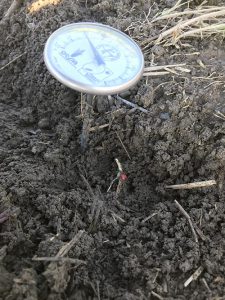
May planted corn is emerged and stands are very good. June 8/9 planted corn will take the week to emerge due to cooler night temperatures and rainy days. Soil temperature Friday morning was 59° F. It’s not the usual June planted corn that jumps out of the ground in a record 92 hours like last year. Temperatures are cooler this year.
With excessive soil moisture, weeds continue to germinate. Grass seed loves to germinate in cool wet soils which is what we have this year. Keep an eye on weed escapes and apply control measures when you are able to.
If you are still thinking of planting corn this year, the Area D crop insurance deadline was June 12, Area A, B and C is extended to June 17. If you need corn for feed and still need to plant past the deadline, you can claim Unseeded Acre Benefit (USAB) and still plant past the deadline, but will not be able to have production insurance coverage. Contact Agricorp for details.
SOYBEANS
Lots of soybeans were planted on the two open planting days in June so far; but there are still many more acres to go.
Farmers are anywhere from zero to 100% planted across the province. Overall acre estimate is around 50% to 60% with the largest unplanted acres in the clay belts of the province.
Fields that are planted will be looking for some weed control applications in the upcoming weeks. As the ground dries and temperatures warm up, keep an eye on temperature inversions and winds speeds and ensure the proper herbicide application with the correct nozzle in order to place the product were it is intended and not in the tree line or your neighbour’s field.
The crop insurance planting deadline for soybeans has been extended five days this year in light of the delayed season. Area E deadline is June 5, Area D is June 25, and Area A,B, C is July 5. Consult Agricorp for details.
WHEAT
Winter wheat is starting to head out and T3 applications are occurring as the crop progresses in maturity. Humid, wet weather at flowering brings the largest risk of fusarium head blight to the crop.
UNSEEDED ACRES
As the wet spring continues, the thought of lots of unseeded acres starts to become more of a reality.
To ensure you are prepared, make sure you contact Agricorp before the June 15 deadline to open up your potential claim on unseeded acres.
When thinking of what to do with the unseeded acres, consider best management practices to improve your soil and condition it for the next crop planting opportunity this fall or next spring.
Unseeded acres this summer will make farmers question their soil management options and consider the implications of doing nothing. Weeds will grow and need to be managed. Consider managing the fields in a way that helps build the soil rather than degrading it.
| Option | Positive Consequences | Negative Consequences |
| Cover crops | Builds soil, retains nutrients, keeps weeds from establishing | Manages residue |
| Tillage | Prepares soil for next crop | Demineralizes soil, soil erosion, nutrient loss |
| Mowing | Keeps weed seed production down | Requires regular mowing |
| Chemical weed control | Keeps weeds down | Needs several applications, keeps land bare and exposed to soil erosion |
| Do nothing | None | Builds weed population, pollutes neighbouring fields with weed seeds |
Update for June 6, 2019
Another week in Ontario and another week of rain. June is starting out to be just as wet as May, but it is warmer and we are starting to see the sun. May had areas of the province where the longest stretch without rain was just two days. That does not make for good planting progress. It has brought on lots of weed growth and fields that were burned down are now seeing another flush of weeds before planting.
CORN
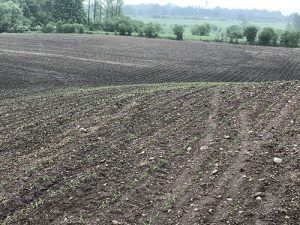
Corn farmers have indicated that their planting progress is anywhere from zero to 100% planted. The average across the province is estimated by many to be around 60% of what was planned. Those plans are continuing to change, and final plantings will be dictated by the next two weeks of weather.
A good commodity price is attracting more farmers to continue to plant corn, while the risk of a cooler season and early fall frost have others concerned as to when is the right time to stop planting corn. Those protected by the lakes with later fall frost dates will continue to plant corn. However, both corn and soybean yield potential decrease as we get into June planting; which crop will bring a better return will depend on when you lock in your price and how you manage your expenses.
Corn planted in mid-May in fields on lighter, drier soils are emerging better than expected, considering all the rain on them. Damp conditions have kept crusting concerns away. That said, some fields with heavy rains right after planting followed by some sun did harden up and farmers have tried to break the crust where possible.
SOYBEANS
Soybean planting has started where fields are dry. Overall estimates are indicating 20% planted for soybeans. Some big soybean regions are at 0% planting due to wet field conditions, it will take dry weather and the rest of the month to get the crop in.
For farmers that have unseeded acres by June 14, they are encouraged to contact Agricorp to inform them of their current planting progress. It doesn’t matter what the crop, or if you still plan on seeding soybeans in late June. Start the process and indicate your planting progress before the June 15 deadline. For the latest announcements on planting deadline extensions please consult the Agricorp web page at http://www.agricorp.com/en-ca/Pages/Default.aspx and click on the 2019 Planting extensions box.
WHEAT
The winter wheat crop in the southwest is approaching heading on earlier planted fields. The first T3 fungicide applications for fusarium control will be applied later this week in Essex and Kent. Growers are reminded to scout fields for proper timing and target the majority of the heads at the right stage. For fields with variable heading dates, farmers will need to consider which wheat crop they want to protect. Think through which crop will be the best to salvage. The main head with largest yield potential? If the section of the field with the later plants are weak and pose the chance of not being harvested (small, light, green kernels), you should focus on the crop that will be harvested. If most of the field is later in maturity, consider spraying time to protect the majority of the yield, it may not be the largest area of the field or the earliest heads, so consider where your yield is coming from.
Joanna Follings, cereals specialist at the Ontario Ministry of Agriculture, Food and Rural Affairs (OMAFRA), has written an article on managing fusarium head blight in 2019 which can be found at: http://fieldcropnews.com/2019/06/managing-fusarium-head-blight-in-the-2019-winter-wheat-crop/
Just think of it, we are making history. Everyone says they have never seen a spring like this one in North America. We are in it together, lets keep everything in perspective and remember to keep yourself and your family safe. Take the time to work safely and be ready to ask a neighbour or friend for help when the weather is good. Everyone wants to help, they just need to be asked.
**********************************
May 30, 2019 – OVER THE PAST few days, as I have travelled through southern and western Ontario, it was all too evident the struggle farmers are facing with this wet spring. Some areas had a nice little bit of ground planted and some areas had no field work done at all. If you averaged it, only about a third of the ground is planted, another third has been worked, and the rest hasn’t been touched. There has been water laying in fields in many counties.
As we see the glassy shine on the fields and know that fields are saturated with three to six inches of rain on it, our thoughts turn to how will the recently planted crop emerge. Every field will be different, and those with good soil heath and porosity will fair better. But as the soils dry, we will need to keep an eye on the activity of the seed beneath the surface, evaluate if a crust is forming, and notice how tight the soils are.
If the seedling is being held back by a crust or tight soils, remediation may be required. Crack the crust once the soil starts to dry to give a point of least resistance for the seedling to emerge from. Prevent further compaction by waiting for the ground to be dry, but don’t wait too long as once the soil is baked, the damage will be done.
Cracking can be done with many different tools you may already have on the farm. If you have to, even running an empty planter with the units up and just a coulter lightly cracking the crust will help. Using a shallow vertical till machine is also a consideration.
SOYBEANS
I had the opportunity to attend the Agribusiness Breakfast Meeting hosted by the Ontario Ministry of Agriculture, Food and Rural Affairs (OMAFRA) this week. At the meeting, it was noted by Horst Bohner, OMAFRA soybean specialist, that as we get into a later timeframe for planting soybeans we will lose 10 per cent yield with June planted soybeans. To help reduce the impact of late planting yield loss, farmers are encouraged to establish their soybean canopy as soon as possible as they will have a shorter growing window. You should focus planting in narrow rows with a higher density to establish a canopy that pushes plants to pod higher. Later planting dates results in shorter and narrower plant development. Push seeding population by 10 per cent in early June and push to 20 per cent after June 15.
WHEAT
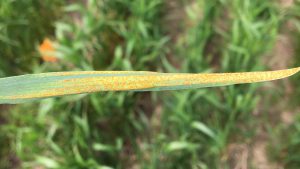
The wheat crop is also under stress in the region. Thinner stands in many fields will result in reduced yields. We will need to manage the wheat crop properly to have a marketable product. Farmers will need to keep an eye on diseases. Stripe rust has been identified in Kentucky and Tennessee and a field has been confirmed in the Wingham area of Ontario (Figure 1). For tips on how to identify and manage strip rust, go to: https://ontariograinfarmer.ca/2017/12/01/cropside-managing-stripe-rust/
Fusarium will need to be managed closely as well this year. Wet weather at flowering will cause our greatest risk for infection. The wheat crop is at different growth phases, so keep an eye on your field and once the majority of the field is at anthesis, get ready to spray. Consult your ag retailer for product options and application rates. More information can also be found here: http://fieldcropnews.com/2017/05/wheat-fungicide-decision-tree-for-fusarium-head-blight-and-stripe-rust/
More topics and detailed minutes of the Agribusiness Breakfast Meetings hosted by OMAFRA can be found at https://fieldcropnews.com.
Marty Vermey is Grain Farmers of Ontario’s senior agronomist. •























